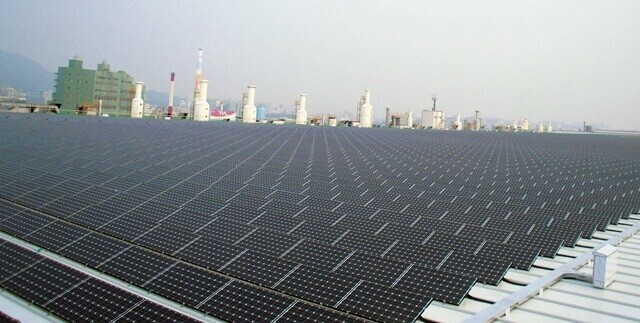hankyoreh
Links to other country sites 다른 나라 사이트 링크
Japan to up reliance on renewably energy up to 38% by 2030, while S. Korea targets 25.8%

The Japanese government plans to increase the proportion of new and renewable energy sources such as solar power to 38% of all electricity generation by 2030.
The South Korean government’s target is 25.8% by 2034 — an aim that is more than 10 percentage points lower than Japan’s and is to be achieved by a later date.
On Wednesday, the Japanese Ministry of Economy, Trade and Industry announced an amended energy framework plan including its intermediate- to long-term energy policy.
It aims to adjust its energy policy to achieve a “post-carbon society” by 2050, meaning one with zero practical greenhouse gas emissions. The amended plan is set to be finalized by the Cabinet this October.
The Japanese government intends to increase its targets for the proportion of new and renewable energy sources such as solar and wind power to 36–38% by 2030, or 14 percentage points higher than the current targets of 22–24%. This would make renewable energy Japan’s mainstay source of electricity generation.
Solar energy is central to that plan, with its proportion to be more than doubled from 7% in 2019 to 15% by 2030. Wind power is also to be expanded from 0.7% to 6%.
One of the drawbacks of the Japanese government’s plan is the difficulty of acquiring suitable locations for eco-friendly renewable energy. Reaching agreements with local residents is another difficult task, as some may object to issues such as facilities detracting from the natural environment.
The Japanese government is currently weighing the possibility of installing solar power generation panels on the roofs of public structures or availing itself of unused farmland. It also plans to take part actively in discussions with different regions to expand infrastructures such as electricity transmission and distribution networks.
Since renewable energy sources are heavily influenced by climate, the central government also plans to supply storage batteries to retain power in preparation for drops in output.
The current target proportion of 20–22% for nuclear power is to be kept in place in the interest of assuring a reliable source of energy.
The Asahi Shimbun newspaper observed that “all 27 reactors for which Nuclear Regulation Authority reviews have been requested would need to be operated to achieve this goal.”
Fifty-four reactors were in operation throughout Japan in the period leading up to the 2011 Fukushima Daiichi Nuclear Power Plant disaster. All of them were taken offline following the accident; 10 are currently back online after a safety review.
Japan further plans to reduce its target proportions for greenhouse gas fuels such as petroleum, coal, and natural gas to 41%, compared with its earlier target of 56%. With fossil fuel power accounting for 76% of generation in 2019, the current plan would nearly halve Japan’s reliance on it by 2030.
After a December 2020 meeting of its new and renewable energy policy review council, South Korea announced plans to increase the proportion of new and renewable energy sources from 5.6% in 2019 to 25.8% by 2034.
By Kim So-youn, staff reporter
Please direct comments or questions to [english@hani.co.kr]

Editorial・opinion
![[Editorial] Yoon must halt procurement of SM-3 interceptor missiles [Editorial] Yoon must halt procurement of SM-3 interceptor missiles](https://flexible.img.hani.co.kr/flexible/normal/500/300/imgdb/child/2024/0501/17145495551605_1717145495195344.jpg) [Editorial] Yoon must halt procurement of SM-3 interceptor missiles
[Editorial] Yoon must halt procurement of SM-3 interceptor missiles![[Guest essay] Maybe Korea’s rapid population decline is an opportunity, not a crisis [Guest essay] Maybe Korea’s rapid population decline is an opportunity, not a crisis](https://flexible.img.hani.co.kr/flexible/normal/500/300/imgdb/original/2024/0430/9417144634983596.jpg) [Guest essay] Maybe Korea’s rapid population decline is an opportunity, not a crisis
[Guest essay] Maybe Korea’s rapid population decline is an opportunity, not a crisis- [Column] Can Yoon steer diplomacy with Russia, China back on track?
- [Column] Season 2 of special prosecutor probe may be coming to Korea soon
- [Column] Park Geun-hye déjà vu in Yoon Suk-yeol
- [Editorial] New weight of N. Korea’s nuclear threats makes dialogue all the more urgent
- [Guest essay] The real reason Korea’s new right wants to dub Rhee a founding father
- [Column] ‘Choson’: Is it time we start referring to N. Korea in its own terms?
- [Editorial] Japan’s rewriting of history with Korea has gone too far
- [Column] The president’s questionable capacity for dialogue
Most viewed articles
- 1Months and months of overdue wages are pushing migrant workers in Korea into debt
- 2Trump asks why US would defend Korea, hints at hiking Seoul’s defense cost burden
- 3[Editorial] Yoon must halt procurement of SM-3 interceptor missiles
- 4At heart of West’s handwringing over Chinese ‘overcapacity,’ a battle to lead key future industries
- 5[Guest essay] Maybe Korea’s rapid population decline is an opportunity, not a crisis
- 6Fruitless Yoon-Lee summit inflames partisan tensions in Korea
- 7First meeting between Yoon, Lee in 2 years ends without compromise or agreement
- 8Dermatology, plastic surgery drove record medical tourism to Korea in 2023
- 9Under conservative chief, Korea’s TRC brands teenage wartime massacre victims as traitors
- 10Anti-immigration candidate marauds across Korea with squad detaining foreigners